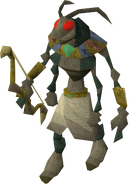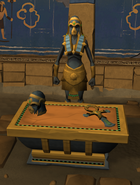| “ | Then he stood, and in a terrible voice he told us that he was Tumeken, patron of these lands. He cursed our treachery, then sorrowfully told the Menaphites that he needed them to join him in making the ultimate sacrifice for their homes and families. | ” |
–Kharshai on Tumeken | ||
| Menaphite Pantheon | |
|---|---|
 | |
|
Race |
Unknown |
|
Gender |
Varies |
|
Alignment |
Varies |
|
Symbol |
Varies |
|
Colors |
Varies |
|
Status |
Varies |
This page addresses information about the Menaphite Pantheon, its religion, and its followers as that information applies to World 42 roleplaying. Any valuable contributors are welcome to add, especially as new content comes out in-game.
The Pantheon[]
So far, eight desert gods have been named. The Menaphite Pantheon is considered to be a "family" despite some of its members not being related by blood.
The Menaphites have been able to directly interfere with events on Gielinor, suggesting that they were not bound by the Guthixian Edicts. Some are known to walk on Gielinor to this day.
The known members of the Pantheon include:
- Tumeken, leader and god of light/the sun
- Elidinis, goddess of fertility, growth, and fresh water
- Icthlarin, god and guide of the dead
- Amascut "The Devourer," goddess of destruction (former goddess of rebirth)
- Scabaras, the exiled god of solitude and wisdom
- Het, god of knowledge and bodily health
- Crondis, goddess of resourcefulness and physical modesty, another belief is followers limiting themselves; taking or using no more of anything than they need (many farmers of the desert follow her)
- Apmeken, trickster goddess of friendship and social pleasures (riddles, playful emotion)
Brief History[]

Symbol of Tumeken
One night, Tumeken fell asleep. During Tumenken's dream, he left Elidinis and traveled through the desert with a waterskin of Elidinis's essence. In the process, he created the four lesser deities Het, Crondis, Apmeken, and Scabaras. At this point, Elidinis was his wife and his two children were Icthlarin and Amascut. He was said to have slept for four days, the first three days having a good dream, the last day having a bad dream. In the bad dream, Scabaras was created.
On a very hot day during the Third Age, a woman named Nardarine escaped the God Wars by venturing into the harsh desert, with no water. Nardarine cried out for help, dying of thirst. Elidinis heard her and made a deal; in exchange for creating the River Elid and giving an offering of food, Nardarine worshipped Elidinis and built the city of Nardah in her honor.

Icthlarin's Symbol
At some point in the Second Age, Icthlarin brought Mahjarrat onto Gielinor from Freneskae. Amascut became somewhat disturbed by witnessing her sibling bringing the Mahjarrat to Gielinor, as they brought great destruction. She vowed vengeance upon her brother and "she brought obliteration, both physical and spiritual." It was after this warping of her mind when she became known and feared as The Devourer. When Tumeken departed on his journey, he marked Icthlarin to rule in his stead, which further angered Amascut.

Amascut's Symbol
Unbeknownst to Amascut, Apmeken and the other minor gods were working to slowly bring peace to the desert. When they succeeded, Amascut was furious; without war, there would not be destruction on the scale she desired. In a fit of rage, Amascut tore away Apmeken's senses; from Apmeken's voice, Amascut made Leeuni, from Apmeken's sight, Amascut made Ayuni and from Apmeken's hearing she made Eruni. Thus Apmeken became unable to talk to the desert peoples, to see what happened in the desert, or to hear prayers.
During the fourth age, Scabaras violated the Edicts of Guthix. Scabaras was banished in part for attempting to "undermine" Elidinis. These actions prompted massive retaliation from much of the Menaphite society. The Menaphites forcefully banished Scabaras from their civilisation, and views on his worship became much darker. According to legend, when Scabaras was banished, his blood spread on the scarabs, turning them into Kalphites.
The Religion[]
The Menaphite religion covers a wide range of areas of desert life and is more about the operation of Kharidan culture than a certain guiding moral or value. The Menaphite Pantheon comes together to inspire and provide for the Kharidan inhabitants in most or all areas of life in exchange for worship and reverence. Each god has his or her own area of expertise and they work together as a team to lead their religion. Most followers of the Menaphite Pantheon worship the entire Pantheon but favor one or two gods, much like Elidinis's followers in Nardah or the Scabaras's scabarites.
Followers and Menaphite Creatures[]
- Most Humans in the Kharidian Desert
- Scabarites (Scabaras)
- Kalphites (Scabaras)
- Crocodiles (Crondis)
- Locusts (Scabaras and others)
- Mahjarrat (formerly)
- Mummies
- Kharidian Monkeys (Apmeken)
- Sphinges (Icthlarin)
- Cats (Icthlarin)
Common Mistakes[]
This category addresses traits that players, often new ones, give their Kharidan characters but that aren't actually seen in worshippers of the Pantheon. That is, a character may have these traits, but it would not be expressly due to the teachings of the Menaphite religion.
- None yet...
Other[]
- The Menaphite Pantheon is very heavily based on ancient Egyptian worship.
- Icthlarin, Amascut, and Apmeken have all appeared to The Adventurer.
- A Camel God supposedly exists though there is little to no knowledge available on him/her, but they are not a part of the Menaphite Pantheon.









